Editorial
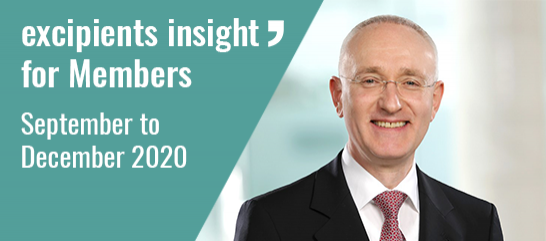
Dear Members,
As we are about to close out a year unlike any other, I would like to take the opportunity in this last edition of the Excipients Insight 2020 to convey my sincere thanks to all our Members, Committee Chairs and Task Force leaders for their commitment to IPEC Europe's projects. You’ve done your utmost to help us make progress in very different circumstances. And of course, I’d like to recognise our Secretariat who keeps our association running as smoothly as ever with additional challenges presented by the pandemic. And finally, thanks to my IPEC Europe Board colleagues for our constructive exchanges during the now nearly routine virtual meetings, and a very warm welcome to Karine Roth (IPSEN) who joins us in the IPEC Europe Board once again.
You may have mixed emotions after this challenging year. On one hand we have had to forego our usual ways of interacting and working. Some objectives may have been reshaped through the year, maybe abandoned even. On the other hand, this experience has pushed our creativity, our resilience and helped clarify our priorities both personally and professionally.
As I write these lines, travel is still not recommended and the virus still persists amongst us, so we as the IE Board took the decision that our Annual Forum in 2021 will be organised remotely. Our Event Committee is working hard to prepare an exciting programme that not only will provide the usual high-quality presentations and still offer networking opportunities. Put a note in your diary!! The 2021 Virtual Forum will be on the afternoons of 3rd & 4th February 2021. To know more, please click here.
Historically, our Annual General Meeting (AGM) takes place on the Friday following the Forum. In 2021 we will push the AGM to beginning of June with the hope that we will be able to gather the IPEC Europe family in person in Brussels. We will keep you posted as soon as more information is available.
Reflecting on 2020, our collaborative efforts allowed us to publish several IPEC Federation guides such as the Excipient Information Package, Excipient Composition, the Incorporation of Pharma Excipients into Product Development using QbD, and the GMP certification Scheme and Certification Body qualification guide for Pharmaceutical Excipients. We also contributed to consultations issued by DG SANTE and EMA on the future of the EU healthcare system. We organised several webinars through the year on subjects such as continuous manufacturing and data integrity which were well attended.
The Board met by web conference at end of November to review the achievements of the year and prepare objectives for 2021. Another meeting is planned in January to finalise our plans and we will be communicating with you after then.
In the meantime, I wish you and your close ones a wonderful holiday season despite the current situation and I extend my best wishes for the New Year, hoping that we will see the end of this pandemic and we will meet again in person.
Take care,
Frithjof Holtz
IPEC Europe Chair
IPEC Europe Forum 2021 goes virtual – registration now open
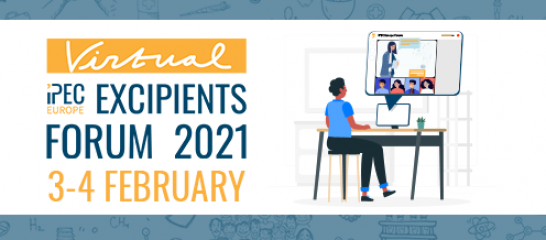
Join us online on Wednesday 3rd and Thursday 4th February 2021 at the IPEC Europe Excipients Forum to discover, experience and discuss the latest innovations and developments in the pharmaceutical excipients sector.
Recognised to be a key event for excipient leaders, the Forum is being hosted this year as a virtual event to prioritise the health and safety of our attendees.
This new experience will still give you great learning and networking opportunities, all from a screen near you!
The programme will cover many ‘hot’ topics, including:
- The regulator's experience of the COVID-19 pandemic
- Excipients and continuous manufacturing
- Nitrosamine impurities
... as well as other themes to be announced in the near future.
We are looking forward to exciting discussions with you!
To register: https://www.ipec-europe.org/events/2021-forum.html
IPEC Europe Annual General Meeting in June 2021
In view of the current pandemic situation, we would like to inform you that the IPEC Europe Annual General Meeting (AGM) will be organised in early June 2021.
In previous years, our AGM was organised in February on the Friday following the IPEC Europe Forum.
We very much hope this change will allow us to host the AGM as a face-to-face meeting in Brussels, Belgium. We would revert to an on-line event if restrictions on group meetings are still in place.
Final decisions regarding the date and the format of the meeting will be made early in 2021 by the Board, and will be duly communicated on our website and via e-mail to all members.
Please make a note in your diary and enjoy the festive season!
Updates from IPEC Europe: Board and Committees
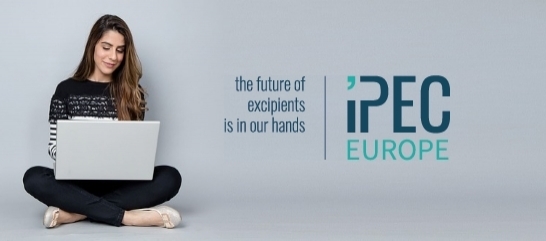
Board
The IPEC Europe Board convened for the third and fourth virtual meeting of the year by web conference on 23 September and on 24 November. Here are some highlights:
- The Board members took stock of the progress of the 2020 objectives, reviewed the achievements of the year and prepared objectives for 2021.
- The events calendar has been severely disrupted by Covid19. The IPEC Europe Excipient Conference webinar series was organised (see dedicated article) on 17-18 September.
- The Board decided to organise the Forum 2021 as an online event in February and organise the AGM in early June. More information in the dedicated articles.
- The Board welcomed back K. Roth (IPSEN).
- The budget 2020 was reviewed and the Board started to put together a provisional budget for 2021.
- The Board also discussed IPEC Europe’s expectations from IPEC Federation, including the organization of global webinars accessible to all the members of regional IPECs.
Board members also attended the regular teleconferences organised by EDQM with the industry association. A valuable opportunity to exchange directly with EDQM representatives and receive regular updates on the latest development on the COVID-19 and other topics.
Good Distribution Practices Committee
The GDP Committee reunited in August, September and December to progress on several activities. Members of the committee contributed to the “EXCiPACT Annex to ISO 9001:2015 Additional Requirements for GWP for Pharmaceutical Excipients” document and the updated version of the IPEC Glossary. Further progress was made on the GDP Audit Guide. The status of the Excipient Transportation Project was discussed too.
Quality and Regulatory Affairs Committee
On 27 October and on 3 December, the Quality and Regulatory Affairs Committee met virtually to finalise the objectives for the year 2020 and draw on future activities in the upcoming year.
Participants received updates on the development of IPEC Federation guides, and on activities of task forces. The new version of the Good Manufacturing Practices Guide, planned for publication in early 2021, will include practical examples (see dedicated note).
Members also discussed several regulatory initiatives open for comments, such as the revised draft of the ICH Guideline Q3D (R2) on elemental impurities and the USP draft Roadmap for Addressing Element-Specific Chapters and Tests on Excipient Monographs.
The Nitrosamines Task Force reconvened to review the IPEC Europe questionnaire and update it according to the latest publication of the EMA and FDA on the matter and the learnings from the first version. The report of second survey on the need for an EMF system is being finalised. Key messages supporting an approach will be shared with collaboration partners with a view to engaging them and indeed regulators in this important initiative. Meanwhile, the ongoing saga with Titanium Dioxide (E171) continues. With a growing momentum of further restricting its use in foods and potentially medicines, QRAC is considering options as to how pharmaceutical applications can be ring-fenced and so limit the impact of what has now become a political issue built around this material’s nanoparticle content. On that same topic, early in 2021 a subgroup will deliver an IPEC Europe position on nanoparticles as well as a review of the various global perspective of what constitutes a nanomaterial. And onto Microplastics! While official publication of the SEAC and RA papers have just been released, once the final details are evaluated, members will be advised of their responsibilities. It is noteworthy that following the first consultation, soluble polymers are now exempt from the recommendations and labelling requirements.
IPEC Federation: five updated guides in 2020
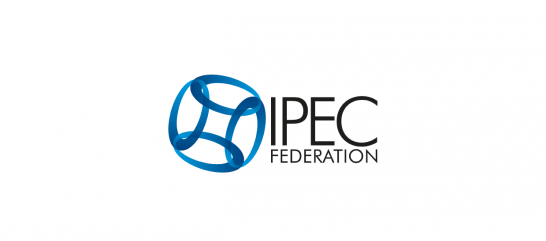
The collaborative efforts of the five IPECs allowed to publish five IPEC Federation guides in 2020, of which two new guides and three revisions. Below, a short summary of all guides published by the IPEC Federation and the links to access them.
Qualification of Excipients for Use in Pharmaceuticals – Guide and Template
The primary goal of the Qualification of Excipients for Use in Pharmaceuticals Guide and Checklist is to identify the minimum information needed to support the marketing of materials for use as excipients as well as their use by pharmaceutical companies.
The checklist was developed as a quick reference for topics to consider during the qualification of an excipient for use in medicinal products.
Download the Guide (Member’s Lab)
GMP Certification Scheme and Certification Body Qualification Guide For Pharmaceutical Excipients – Guide and Template
The guide was developed for excipient users (e.g. pharmaceutical manufacturers) to qualify both certification bodies (CB) that issue excipient GMP and GDP certificates and audit reports as well as Certification Scheme Owners. The use of the guide is intended to facilitate sharing pertinent information from the CBs and Scheme Owners to excipient users in a standardized way.
The guide and its associated “sample” template were designed to facilitate the provision of standardized information from the CB or Scheme Owner to the excipient user.
Download the Guide (Member’s Lab)
Incorporation of Pharmaceutical Excipients into Product Development using Quality-by-Design (QbD)
The primary goal of the QbD guide is to introduce Quality-by-Design (QbD) and pharmaceutical formulation development concepts to excipient manufacturers and suppliers, explain how changes in pharmaceutical formulation practices, due to the introduction of QbD, impact excipient manufacturers and suppliers, help excipient manufacturers and suppliers understand what excipient users will likely require when applying QbD principles during product development, and explain to excipient users and regulatory agencies what may or may not be possible when considering the impact of excipient variability in the application of QbD principles during product development.
Download the Guide (Member’s Lab)
Excipient Information Package – User Guide and Template
The primary goal of the Excipient Information Package (EIP) guide is to facilitate the excipient supplier’s sharing of information with the user in a standardized way rather than completing individual questionnaires and surveys.
The EIP consists of 3 different documents covering quality systems, product regulatory and supply chain and security:
- Product Regulatory Datasheet
- Site Quality Overview
- Supply Chain and Security Overview
Download the Guide – Download the Templates
Excipient Composition Guide
The IPEC Excipient Composition guide provides an approach for excipient manufacturers to establish excipient composition profiles. Composition profiles may be used for regulatory purposes, assessing quality consistency, manufacturing process monitoring and change control, establishing product specifications, or evaluating excipient safety by excipient suppliers and/or users.
Originally a joint IPEC-Americas - IPEC Europe guide, the new Composition Guide now represents inputs from all IPEC members.
Download the Guide
All these guides are available in our Member’s Lab, reserved to IPEC Europe Members.
If you do not have your credentials yet, please contact the Secretariat: info@ipec-europe.org
The Joint IPEC-PQG Good Manufacturing Practices Guide
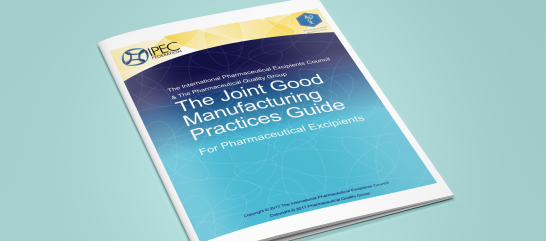
Within the IPEC Federation, a project is ongoing to revise this guide to align the contents with the most recently published ISO 9001 standard on Quality Management (2015). Also, more examples will be added as an Annex to help readers better apply GMP principles to the manufacture of excipients.
This exercise has proven to be very resource intensive however, considerable efforts are being made to ensure that the new revision is finalised in the near term, with the goal of publishing the next version early in 2021.
Announcing a new IPEC Europe member: IPSEN
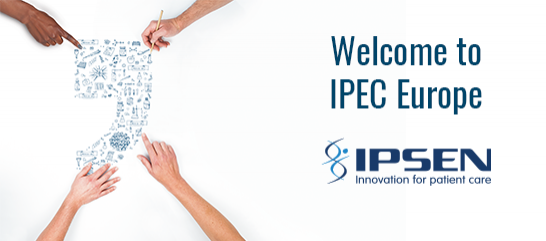
IPEC Europe is glad to welcome that French pharmaceutical company IPSEN as a new member.
Headquartered in Paris, France, IPSEN develops and markets medications used in oncology, neuroscience and rare diseases along with consumer healthcare products.
For further information, please visit the company website www.ipsen.com
The full list of IPEC Europe members is available on the IPEC Europe website.
IPEC Europe Excipient Conference webinar series
IPEC Europe held its first ever webinar series in cooperation with APV on 17 and 18 September, as a partial replacement of the usual two-days conference originally scheduled in Frankfurt, Germany.
The online event attracted more than 50 attendees and featured two presentations on the IPEC technical unavoidable particles (TUP) guideline, presented by Darek Lewin, Head of Pharma at JRS Pharma, and on the choice of excipients for continuous manufacturing, presented by David Schoneker, Black Diamond Regulatory Consulting LLC/IPEC-Americas. The insightful presentations triggered thought-provoking Q&A sessions, moderated by IPEC Europe Senior Advisor Adrian Bone.
Regulatory News: Europe
European Union
A Pharmaceutical Strategy for Europe
The Commission unveiled on November 25 a Pharmaceutical Strategy for Europe to ensure patients have access to innovative and affordable medicines and to support the competitiveness, innovative capacity and sustainability of the EU's pharmaceutical industry. The Strategy, a key part of the proposed Health Union, aims to support the establishment of a pharmaceutical system more resilient and capable to react to crises.
The four main objectives of the European Pharmaceutical Strategy are:
- Ensure access to affordable medicines for patients, and addressing unmet medical needs in areas such as cancer and antimicrobial resistance;
- Support innovation, competitiveness and sustainability for EU’s pharmaceutical industry, and the development of safe, high-quality and greener medicines;
- Enhance crisis preparedness and response mechanisms, and addressing security of supply;
- Ensure a strong EU voice in the world, by promoting a high level of quality, efficacy and safety standards.
Expectations for a launch of specific actions to avoid future shortages experienced during the first phase of the COVID-19 crisis were unmet. The Strategy opens a “structured dialogue with an between the actors in the pharmaceuticals manufacturing value chain and public authorities” to “formulate policy options and propose actions to strenghten the continuity and security of supply in the EU” at a later stage.
European Commission / Euractiv
State of the Union Address includes support to the creation of Health Union
In her first State of the Union speech (the annual keynote speech addressed to the European Parliament plenary session in September) on 16 September, European Commission President Ursula von der Leyen highlighted the need to build a stronger Health Union. In spite of the recent cuts imposed by the European Council to the EU4Health Programme (9.4 bn€ to 1.7 bn€), the EU executive proposed to strengthen coordination between member states and rediscuss the competences on health, currently in the hands of member states. Von der Leyen added that reinforcing the Agency for Infectious Diseases (ECDC) and the European Medicines Agency (EMA) is being considered.
Euractiv / State of the Union Address
Drug shortages: European Parliament calls for action
In the September plenary session, the European Parliament unanimously called for the EU to be more active in addressing drug shortages and supply disruptions, also by empowering the European Medicines Agency.
MEPs also seek to reduce the EU’s reliance on foreign companies for APIs and finished products, a measure that could translate into regulations if supported by the European Commission. The text mentions that “these strategies must include regulatory measures and encourage the production of essential APIs and medicines in Europe with the aim of making medicines available, affordable, sustainable and equally accessible”.
The Parliament plenary called also for the creation a legal basis for more transparency on the origin of drugs and APIs “at raw material production stage” for environmental purposes. The objective is to set up a centralised database containing the results of environmental risk assessment of product to measure the impact pharmaceuticals can have on “water, environmental behaviour, degradability”.
European Parliament (Adopted text)
European Directorate for Quality of Medicines (EDQM)
Nitrosamine impurities: new general chapter published
During its 168th Session, the European Pharmacopoeia Commission adopted a new general chapter on the analysis of N-nitrosamine impurities in active substances (2.5.42, previously listed as 2.4.36). The new general chapter proposes three procedures and focuses mainly on the analysis of N-nitrosamine impurities in angiotensin-II-receptor antagonists (sartans) containing a tetrazole group, for which there are five Ph. Eur. monographs (valsartan, losartan potassium, candesartan cilexetil, irbesartan and olmesartan medoxomil), but may also be helpful to establish a control strategy for other active substances or for medicinal products.
A webinar will be hosted on January 21st to provide an overview of the new chapter.
EDQM
Certification of Suitability: Survey published
EDQM has launched a public consultation on the future of the Certificate of Suitability (CEP). The declared aim of the consultation is “to develop a “new-look” CEP that will better fit the emerging needs of stakeholders and offer both enhanced user-friendliness and greater transparency of the information conveyed without, however, increasing the administrative regulatory burden related to their revision”.
The consultation is open until 31 December 2020 as an online survey. A “read only” version of the survey is also available to help all stakeholders prepare their answers in advance.
EDQM
Pharmeuropa 32.4 released: comments until 31 December
The latest issue of Pharmeuropa contains 42 drafts published for review and comments. The full list is available here. The deadline for comments is 31 December 2020.
Pharmeuropa
New Council of Europe resolution to strengthen safety of food contact materials
The Council of Europe adopted a new resolution on the safety and quality of materials and articles for contact with food in mid-October. This instrument is expected to improve the protection of consumers from contaminants (metals, antioxidants, stabilisers, colorants, plasticisers, etc.) potentially released by material in contact with food, such as containers, work surfaces or packaging.
Resolution / EDQM
European Medicines Agency (EMA)
GMP/GDP Distant assessment guidance
EMA published a GMP/GDP Distant Assessment Guidance that provides insights to inspectors on remote assessments when on-side inspections may not be possible. Distant Assessments (or remote audits) are a useful instrument to support and help determining compliance, and this document provides useful guidance to GMP and GDP auditors in the pharmaceutical and API sector.
EMA
EU regulators request nitrosamine testing of metformin medicines
The CHMP committee announced after the September meeting that EMA and the national competent authorities will ask MAHs for metformin-containing medicines to test their medicines for the presence of nitrosamines before releasing them onto the market.
The Agency stresses that this a precautionary step to ensure patient safety while the investigation is ongoing.
News / EMA
How incidents with medicines are managed in the EU – a ten-year analysis
A recent analysis covering the activities of the European Union Incident Management Plan (EU-IMP) states that the EU medicines network is supported by a robust regulatory framework to handle public health incidents. The EU-IMP, established by EMA in cooperation with the Heads of Medicines Agencies and the European Commission in 2009, enables a rapid and effective response to events or information on medicines with a potential impact on public health.
EMA / Article
Virtual meeting: develop and authorisation of safe COVID-19 vaccines
EMA organised a virtual meeting on 11 December to explain the processes for the development, evaluation, approval and safety monitoring of COVID-19 vaccines in the EU.
EMA / YouTube
Medicines and Healthcare products Regulatory Agency (MHRA)
MHRA joins Consortium of Regulators with Australia, Canada, Singapore and Switzerland
The MHRA has joined the Australia-Canada-Singapore-Switzerland (ACSS) Consortium. The ACSS consortium, formed in 2007, included the national regulatory authorities of Australia, Canada, Singapore and Switzerland, will be known as “Access Consortium”. The MHRA will start working with consortium partners in January 2021.
MHRA
Consultation response and Strategy: Application of Analytical Quality by Design concepts to pharmacopoeial standards for medicines
After the consultation on the application of Analytical Quality by Design (AQbD) principles to pharmacopoeial standards for medicines, the MHRA elaborated and reviewed the responses received, to then develop a clear position on the value of the application of AQbD. The strategic objectives identified are: 1) Develop and publish new standards and guidance; 2) Further explore the application of AQbD concepts; 3) Build capability across the Agency; and 4) Engage and collaborate with stakeholders.
MHRA
European Chemicals Agency (ECHA)
Restriction proposal on intentionally-added microplastics
The ECHA updated its proposal to restrict intentionally-added microplastics in September with responses to the comments collected in the six-month consultation of stakeholders. The changes proposed by the Agency are detailed in the draft background document. Updates were introduced, among others, to the definition of a microplastic. The Q&A document on the main updates to the restriction proposal is available here.
ECHA
Regulatory News: rest of world
U.S. Food and Drug Administration (FDA)
Inactive Ingredient Database now including MDE per route of administration
The FDA is updating the Inactive Ingredient Database to include accurate Maximum Daily Exposure (MDE) information for excipients for all available routes of administration. This reflect the commitment made by the Agency in the reauthorisation of the Generic Drug User Fee Amendments (GDUFA) for the period 2018-2022.
MDE information was included in the Database for the first time in late July. More excipient MDEs will be included in future IID versions.
FDA
Guidance for Industry: Control of Nitrosamine Impurities in Human Drugs
This FDA guidance recommends steps that manufacturers of APIs and drug products should take to detect and prevent objectionable levels of nitrosamine impurities in pharmaceutical products. The guidance also describes conditions that may introduce nitrosamine impurities. The recent unexpected finding of nitrosamine impurities has made clear the need for a risk assessment strategy to identify and minimize nitrosamines in any pharmaceutical product at risk for their presence.
FDA
Webcast: Overview of the Guidance for Industry - Control of Nitrosamine Impurities in Human Drugs
On September 2, 2020, FDA published a guidance for industry entitled Control of Nitrosamine Impurities in Human Drugs. In this webcast, FDA reviews the guidance recommendations and industry expectations related to the steps manufacturers of APIs and drug products should take to detect and prevent unacceptable levels of nitrosamine impurities in pharmaceutical products. Additionally, FDA reviews the conditions that may introduce nitrosamine impurities and the need for a risk assessment strategy for potential nitrosamines in any pharmaceutical product at risk for their presence.
Click here to watch the recording.
FDA via IPEC-Americas
U.S. Pharmacopoeia (USP)
New notice of Intent to Revise Monographs Affected by Revision to <1195> General Chapter
In response to the revision of the General Chapter <1195> Significant Change Guide for Bulk Pharmaceutical Excipients, due to be published in USP-NF2021, Issue 1, two monographs will be revised:
- <1080> Bulk Pharmaceutical Excipients—Certificate of Analysis
- <1197> Good Distribution Practices for Bulk Pharmaceutical Excipients
USP
International Council for Harmonisation (ICH)
ICH updates focus on drug development, elemental impurities
ICH met virtually on 18 November for the second time of the year, showing progress in topics such as elemental impurities and the role of patients in drug development.
Two groups reached step 2 – one is the working group focused on the ICH Q3D(R2) Guideline for Elemental Impurities is addressing amendments to the PDE for gold, silver and nickel and limits for elemental impurities by cutaneous and transcutaneous routes, the other one is working on the ICH M7 Q&A document on
Assessment and Control of DNA Reactive (Mutagenic) Impurities in Pharmaceuticals to Limit Potential Carcinogenic Risk. ICH is working on the topic in the belief there is value in the further harmonization of the regulation of mutagenic impurities in pharmaceuticals.
ICH
Revision of Q3D(R1) for cutaneous and transdermal products: Q3D(R2) maintenance concept paper available
The Q3D(R2) Maintenance EWG is currently undertaking a maintenance of the Guideline to develop PDE levels for cutaneous and transdermal products. The document available for public consultation includes the proposed revisions to the Q3D(R1) guideline can be accessed here.
ICH
International Coalition of Medicines Regulatory Authorities
COVID-19 – re-cap page
During the ongoing COVID-19 pandemic, the International Coalition of Medicines Regulatory Authorities (ICMRA) is acting as a forum to support strategic coordination and international cooperation among global medicine regulatory authorities. After the collective statement published in April, ICMRA members committed to prioritise COVID-19 clinical trials to expedite vaccines development and approval.
ICMRA
Recommended readings

EAEU Pharmacopoeia: Volume 1 published
The Eurasian Economic Commission published the Volume 1 of the EAEU Pharmacopoeia. Available in Russian, the first volume includes 157 general texts and monographs. A second volume is being developed and is expected to include individual monographs. The EAEU Pharmacopoeia will enter into force on March 1, 2021.
Eurasian Economic Union
Continuous Manufacturing: ICH Q13
Although steps have been taken to enable the implementation of continuous manufacturing in industry, a lack of global harmonisation in regulations has slowed the adoption of this promising emerging technology. An expert looks at how ICH Q13 seeks to provide a harmonised approach.
European Pharmaceutical Review
Biologically Active Excipients?
Are APIs the only drug ingredients with biological activity? That’s certainly the case for the vast majority of formulations, but new research suggests that a notable minority of excipients aren’t quite as inert as previously thought. A research article appeared on Science examined excipient activity by combining large-scale computational screening with targeted experimental testing.
The Medicine Maker / Science ($)
|